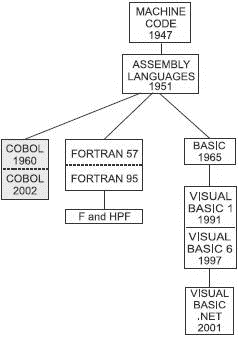Книга: Introduction to Microprocessors and Microcontrollers
Cobol
Cobol
Fortran and Basic, the son of Fortran, did not make enormous steps towards employing normal English language phrases. This was attempted by the US Defense Department who introduced Cobol in 1959 – just before Basic (see Figure 10.6). Its purpose was not number crunching, like Fortran, but information handling. It proved to be successful at this and spread from the US Navy where it kept records of stocks and supplies, to the business world. The name was derived from COmmon Business Oriented Language.

Figure 10.6 This is the business
Cobol was designed, more in hope than reality, to be easily read by non-programmers. However, it looked friendlier than the mathematical approach of Fortran and has survived to the present day. It is generally used by large corporate computers rather than Desktop PCs.
Large businesses handle enormous amounts of information data. Just imagine the amount of information involved in a few everyday activities. We apply to open a bank account – a form appears asking an almost infinite number of questions. Then we want a credit card – more forms, more information mostly the same as we gave them for the bank account. Then we buy something. What we bought, its stock number, its price, the date, our card number, and name are all transmitted to the national card centre and our account is amended. None of these transactions involve particularly complicated mathematics. The calculations are basically addition and subtraction of totals. So the calculating ability of Cobol does not need to rival Fortran or even Basic. But what it can do it to extract related information – put in our post code and out comes all sorts of information about us – credit rating, employment, home address, hobbies, purchasing patterns and almost anything else they want. Some of this information is bought and sold between companies without reference to us.
Like Fortran, it has survived by meeting a specific need and has had a series of upgraded standard versions. They refer to the date of adoption: Cobol 60, Cobol 74, Cobol 85, Cobol 97 and the new 2002 version.
A real effort was made to allow the language to be understood by those who know more about English than about programming. To this end, Cobol statements are English phrases including a verb and ending with a comma. The phrases can be joined up to form a sentence or a single statement can end with a period (full stop).
A line may read:
1 Add staff to customers to give total people.




